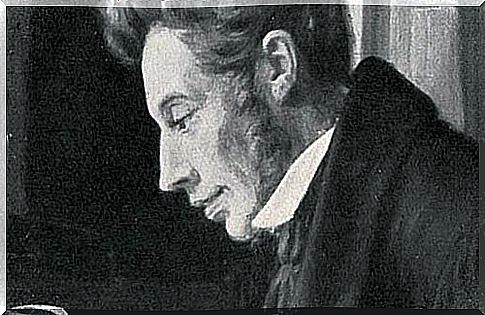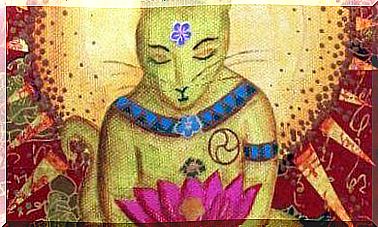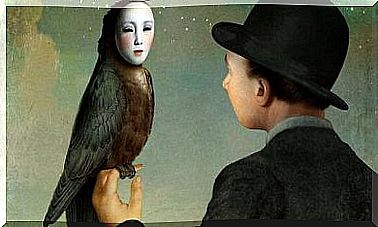Soren Kierkegaard: The Biography Of The Father Of Existentialism

They say that Soren Kierkegaard loved Regina Olsen until the last day of her life. However, his purpose was to devote himself, body and soul, to the study of philosophy and Christian faith. This Danish theologian and philosopher has always dealt with the weight of this anguish, with the suffering of not being able to free himself from his affections. However, thanks to this, he was able to shape his theoretical legacy.
Kierkegard’s work is based on the meaning of faith. Only through this dimension would it be possible to achieve salvation and balance in times of despair. This perspective was, at the same time, a reaction to Hegel’s idealism. Furthermore, an aspect that defined the famous Danish philosopher was also his critical voice to religious institutions that acted, according to him, with hypocrisy.
In his books, Fear and Tremor, Philosophical Crumbs or Diary of a Seducer , we understand this dualism that has permeated his entire life. Love, suffering and impossible passion in the face of the need to dedicate himself to theology marked the tumultuous daily life of one of the most relevant and interesting figures in philosophy.
Thus, while the Danish church proposed a rational God who rewarded good works, Kierkegaard’s God did not know about devotions, only responded to fear. His philosophy laid the foundations for twentieth-century existentialism.
He defined human subjectivity and the individual as no one else to differentiate him from the masses, and he also served as an inspiration for thinkers such as Jean-Paul Sartre, Friedrich Nietszche and Albert Camus.

The biography of Soren Kierkegaard
Soren Kierkegaard was born into a wealthy Copenhagen family in 1813. He was the son of Michael Pedersen Kierkegaard , a very religious Jutland pastor with a rather puritanical sense of existence. His mother was Anne Sorensdatter Lund Kierkegaard, a young servant whom Michael Kierkegaard made pregnant, a fact that has always weighed on him as a sin.
Young Soren attended the School of Civic Virtue and then continued with his father’s plans: to study theology at the University of Copenhagen. However, it is worth noting that he was always more interested in philosophy and literature. At the same time, a remarkable fact of his early youth was meeting, at just 15 years of age, Regina Olsen, with whom he became committed when he finished his studies.
However, his father died in 1838, not before making Soren promise him something very specific: that he would become a pastor, that he would dedicate his life to God and to his studies. The weight of that promise became, therefore, that anchor that irremediably slowed down her affective life. He broke his commitment to Regina, made her return the ring, and later went to Berlin.
The next 10 years would be the most productive of this young theologian’s life. The creation that originated in this period was undoubtedly one of the most important in the history of literature.
love, guilt and suffering
In 1943, Soren published 6 works. One of them was Fear and Tremor , in which he delves into a theme that will be recurrent in most of his works: his love for Regina. In this work, he navigates through guilt, pain and the devout sense of obedience to his religion. Exactly that same year, upon returning to Copenhagen, he discovers that the young woman had just married Fritz Schegel.
That fact completely ends any second chance. Something that he himself had prevented, now loomed as an even harsher and immeasurable reality. The months that followed this event were also very fruitful from a literary and philosophical point of view.

For example, his works aimed at criticizing the theories of Georg Wilhelm Friedrich Hegel stand out. Books such as Philosophical Crumbs, The Concept of Anguish and Stages of the path of life deal with these thoughts and emotional realities felt by the person facing adversity, a topic in which he was a true expert.
Soren Kierkegaard and his brother Peter were, little by little, becoming the only survivors of a family marked by tragedy. The father always reminded them that they were cursed, that the shadow of sin hung over them, and that, therefore, they would all leave this world sooner. Ironically, this “prophecy” was fulfilled, because he himself would end up dying prematurely at 42 years of age.
It was never quite clear what the cause of his death was. It is known that he had some kind of frailty, that his health was never good. However, this did not prevent it from leaving us an intense and exceptional literary and philosophical legacy. At the same time, it is interesting to highlight a detail: Soren Kierkegaard included Regina in his will.
Soren Kierkegaard’s legacy
William James often liked to quote one of Soren Kierkegaard’s best-known phrases: “we live forward, but we understand backward.” He was the Danish philosopher and theologian of subjectivity. So, and although at first it seems that everything he left us was impregnated with a certain negativity and despair, it is worth noting that it was not like that.
Soren taught us that living is knowing how to choose. He made us see that in each choice our existence is formed to define who we are and what we are leaving behind. At the same time, I also wanted to make an effort to make people understand the meaning of anguish and suffering. This is all part of life, and the only way to alleviate pain is, according to Kierkegaard, through faith.

The writer of pseudonyms and existentialism
Soren Kierkegaard performed much of his work under various pseudonyms such as Victor Hermit, Johannes de Silentio, Anti-Climacus, Hilarante Bookbinder or Vigilius Haufniensis . Acting in this way had a very specific purpose: to represent different ways of thinking.
This strategy defined what he called “indirect communication”. In this way, he could explore points of view that were different from his own and reach the reader in a richer and deeper way. At the same time, one of Kierkegaard’s purposes was also to teach how a person could lead his life, thus establishing three types of existence:
- The first sphere is the aesthetic sphere. This defined a mode of existence centered on pleasure, hedonism or nihilism.
- The ethical sphere shapes an existence in which the individual is able to take responsibility for himself. In it, the person is able to differentiate “good and evil” and be consistent with these principles.
- The religious sphere was the highest for Kierkegaard. In it, the human being reaches a personal relationship with God, from which he could reach nobler purposes.
The philosopher of anxiety, the philosopher of self-irony
Figures like Albert Camus did not hesitate to define Soren Kierkegaard as the philosopher of self-irony. He was a theologian who defended the faith above all things, but who never hesitated to attack the Danish church. He was a young man who rejected the love of his life, but who never stopped loving the girl who served him as the absolute muse in most of his works.
While always exalting the need to cultivate a religious spirit, he lived immersed in an aesthetic-ethical sphere.
Another aspect that defined it was the concept that would mark the work of great later writers, such as Kafka, Unamuno or the philosopher Ludwig Wittgenstein. We refer to anguish. This state (in Danish: begrebet angest ) also defines an experience in which we suddenly become aware that there are more options, that we are free to jump into the void or even take a step back and seek other paths.
There are always alternatives to suffering, but suffering also helps us to grow. Soren Kierkegaard’s teachings, as we see, will always be present.









